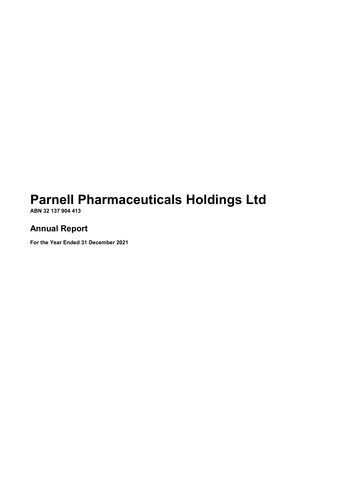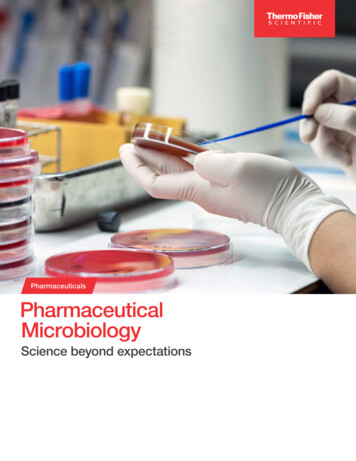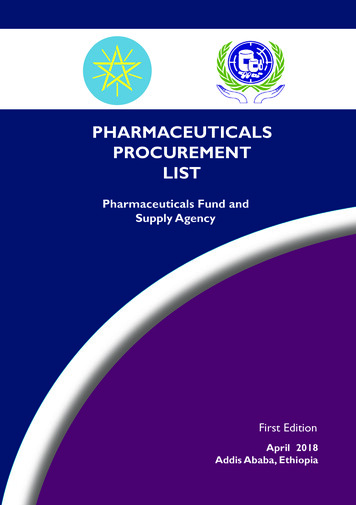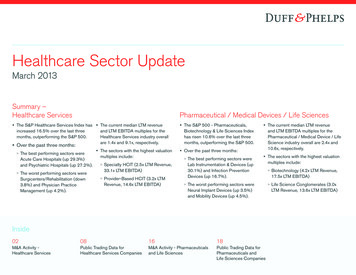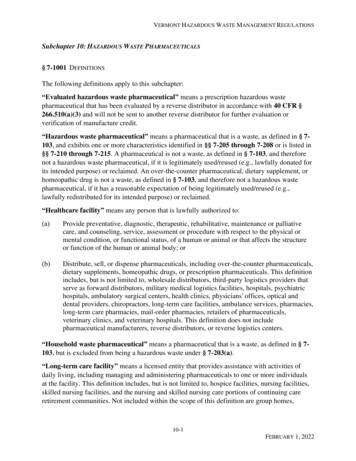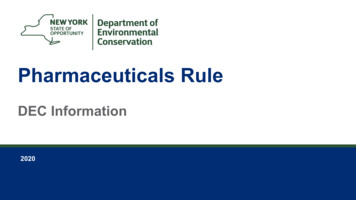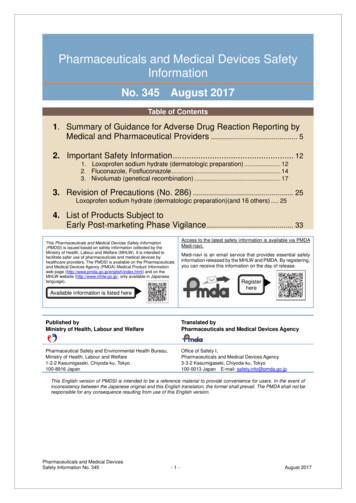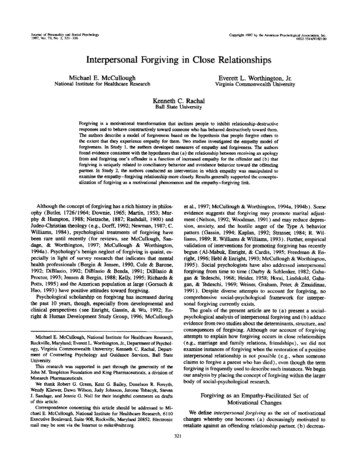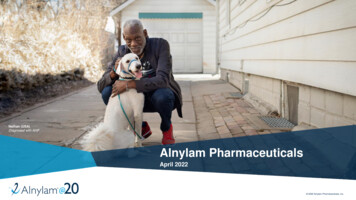
Transcription
Nathan (USA)Diagnosed with AHPAlnylam PharmaceuticalsApril 20221 2022 Alnylam Pharmaceuticals, Inc.
Alnylam Forward Looking StatementsThis presentation contains forward-looking statements within the meaning of Section 27A of the Securities Act of 1933 and Section 21E of the Securities Exchange Actof 1934, including expectations regarding our aspiration to become a leading biotech company and the planned achievement of our “Alnylam P5x25” strategy, our abilityto attain financial self-sustainability, the drivers of our future growth potential, including the potential of our TTR franchise, our continued confidence in the design andongoing execution of the APOLLO-B Phase 3 study and the evidence for investigational RNAi therapeutics in ATTR cardiomyopathy, the potential opportunity for RNAitherapeutics in prevalent diseases, and the potential of our engine for sustainable innovation including the potential for improved product profiles to emerge from ourIKARIA and GEMINI platforms, as well as the achievement of additional pipeline and regulatory milestones. Actual results and future plans may differ materially fromthose indicated by these forward-looking statements as a result of various important risks, uncertainties and other factors, including, without limitation: the direct orindirect impact of the COVID-19 global pandemic or any future pandemic on our business, results of operations and financial condition and the effectiveness ortimeliness of our efforts to mitigate the impact of the pandemic; the potential impact of the recent leadership transition on our ability to attract and retain talent and tosuccessfully execute on our “Alnylam P5x25” strategy; our ability to discover and develop novel drug candidates and delivery approaches, including using our IKARIAand GEMINI platforms, and successfully demonstrate the efficacy and safety of our product candidates; the pre-clinical and clinical results for our product candidates,including vutrisiran and patisiran; actions or advice of regulatory agencies and our ability to obtain and maintain regulatory approval for our product candidates,including vutrisiran, as well as favorable pricing and reimbursement; successfully launching, marketing and selling our approved products globally; delays, interruptionsor failures in the manufacture and supply of our product candidates or our marketed products; obtaining, maintaining and protecting intellectual property; our ability tosuccessfully expand the indication for OXLUMO, ONPATTRO (and potentially vutrisiran, if approved) in the future; our ability to manage our growth and operatingexpenses through disciplined investment in operations and our ability to achieve a self-sustainable financial profile in the future without the need for future equityfinancing; our ability to maintain strategic business collaborations; our dependence on third parties for the development and commercialization of certain products,including Novartis, Sanofi, Regeneron and Vir; the outcome of litigation; the potential impact of current and risk of future government investigations; and unexpectedexpenditures; as well as those risks more fully discussed in the “Risk Factors” filed with our most recent Annual Report on Form 10-K filed with the SEC and in ourother SEC filings. If one or more of these factors materialize, or if any underlying assumptions prove incorrect, our actual results, performance, timelines orachievements may vary materially from any future results, performance or achievements expressed or implied by these forward-looking statements. All forward-lookingstatements speak only as of the date of this presentation and, except as required by law, we undertake no obligation to update such statements.2
Alnylam Poised to Become a Top-Tier BiotechLeader in RNAi Therapeutics Pioneered new class of innovative medicines4 medicines approved in 3 yearsRobust clinical pipeline across rare and prevalent diseasesGlobal footprint with strong commercial capabilitiesLeading IP estate with fundamental, delivery, and product-specificpatent protection Strong balance sheet, on path toward financial self-sustainabilityHighly differentiated with proven track record andderisked platform 3Modular and reproducible approach to drug developmentHistoric probability of clinical success multiples higher than industry standardsOrganic product engine capable of sustaining innovation for future growthTrack record of setting and exceeding 5-year goals
Notable Accomplishments in 2021Combined net product revenues of 662 million(83% growth YoY)Completed enrollment in two keyPhase 3 studies in ATTR amyloidosis w/ CM2Expanded commercial presence into 30 countriesLaunched new 5-year strategy4 NDA/sNDA submissions(vutrisiran, lumasiran)Advanced multipleinvestigational productsfor prevalent diseases(zilebesiran, ALN-HBV02,ALN-HSD)Maintained strong financial position 2.4 billion in cashat year-end 2021 120M YoY improvementin non-GAAP operating loss2CTA filings(ALN-APP,ALN-XDH)
Continuing Strong Global Commercial ExecutionCombined Net Product Revenues ( 662M) at Upper End of Guidance Range, with 83% YoY Growth M 475M 128M 60M2021 revenues2021 revenues2021 revenues138.6ROWU.S.113.8102.061.4120.378.5 M .29.17.717.86.55.25.7Q3 2021Q4 20211.4Q1 2021Q2 2021Q3 2021Q4 2021Q1 2021Q2 2021 2,050 patients 350 patientsas of December 31, 2021as of December 31, 2021 1,725 2,050Q3 2021Q4 2021 350Q1 2021 140 patients 140as of December 31, 2021 300 1,875 120 270 1,500Q2 2021 100 225 50Q1 20215Q2 2021Q3 2021Q4 2021Q1 2021Q2 2021Q3 2021Q4 2021Q1 2021Q2 2021Q3 2021Q4 2021
Alnylam Clinical Development PipelineFocused in 4 Strategic Therapeutic Areas (STArs):Genetic MedicinesInfectious DiseasesCardio-Metabolic DiseasesCNS/Ocular DiseasesEARLY/MID-STAGELATE STAGE(IND/CTA Filed-Phase 2)(Phase 2-Phase 3)REGISTRATION/COMMERCIAL1(OLE/Phase 4/IIS/registries)COMMERCIALRIGHTShATTR Amyloidosis with PN2GlobalAcute Hepatic Porphyria3GlobalPrimary Hyperoxaluria Type 14GlobalMilestones & up to 20% Royalties6Leqvio (inclisiran)Hypercholesterolemia5Vutrisiran*hATTR Amyloidosis with PNGlobalPatisiranATTR Amyloidosis with CMGlobalVutrisiran*ATTR Amyloidosis with CMGlobalVutrisiran7*Stargardt DiseaseGlobalFitusiran*HemophiliaLumasiranSevere PH1Recurrent Renal StonesCemdisiran ( /- Pozelimab)8*Complement-Mediated DiseasesBelcesiran9*Alpha-1 Liver DiseaseALN-HBV02 (VIR-2218)10*Hepatitis B Virus InfectionZilebesiran PP*Alzheimer’s Disease;Cerebral Amyloid Angiopathy50-50ALN-XDH*GoutGlobal15-30% RoyaltiesGlobal50-50; Milestone/RoyaltyEx-U.S. option post-Phase 350-50 option post-Phase 216Includes marketing application submissions; 2 Approved in the U.S. and Canada for the PN of hATTR amyloidosis in adults, and in the EU, Japan and other countries for the treatment of hATTR amyloidosis in adults with stage 1 or stage 2 polyneuropathy; 3 Approved in the U.S., Brazil and Canada forthe treatment of adults with acute hepatic porphyria (AHP), and in the EU and Japan for the treatment of AHP in adults and adolescents aged 12 years and older; 4 Approved in the U.S., EU and Brazil for the treatment of primary hyperoxaluria type 1 in all age groups; 5 Approved in the U.S. for thetreatment of heterozygous familial hypercholesterolemia (HeFH) or clinical atherosclerotic cardiovascular disease (ASCVD) and in the EU for the treatment of hypercholesterolemia or mixed dyslipidemia; 6 Novartis has obtained global rights to develop, manufacture and commercialize inclisiran; 50% ofinclisiran royalty revenue from Novartis will be payable to Blackstone by Alnylam; 7 Phase 3 study of vutrisiran in Stargardt Disease expected to initiate in late 2022; 8 Cemdisiran and pozelimab are each currently in Phase 2 development; Alnylam and Regeneron are evaluating potential combinations ofthese two investigational therapeutics; 9 Dicerna is leading and funding development of belcesiran; 10 Vir is leading and funding development of ALN-HBV02; * Not approved for any indication and conclusions regarding the safety or efficacy of the drug have not been established.As of April 2022
High-Yield Productivity of Alnylam RNAi Therapeutics PlatformComparison of Historical Industry Metrics to Alnylam Portfolio1Probability of Success (POS) by Phase Transition1009087.585.785.7Percent 05.70% POS, Phase 1 to 2Alnylam21% POS, Phase 3Industry (biomarker-driven programs)3Analysis as of November 2021; Past rates of Alnylam and industry respectively may not be predictive of the futureAlnylam programs biomarker-driven at all stages of development (100%); figures include Alnylam-originated molecules now being developed by partners3 Wong et al., Biostatistics (2019) 20, 2, pp. 273–28627% POS, Phase 2 to 3% POS, CumulativeIndustry (overall)3
2022 Expected to Deliver Multiple Catalysts with Value-Creation PotentialFull 18-Month HELIOS-A Phase 3 Results with VutrisiranCemdisiran Phase 2 Data in IgA NephropathyPotential FDA Approval of Vutrisiran8January 21, 2022Société Francophone du Nerf PériphériqueEarly 2022Mid-2022(PDUFA date July 14, 2022)APOLLO-B Phase 3 Results with PatisiranMid-2022ALN-HSD Phase 1 Part B Topline Results in NASH PatientsMid-2022Vutrisiran Biannual Dose Regimen DataLate 2022ALN-APP Phase 1 Topline ResultsLate 2022KARDIA-1 Phase 2 Topline Results with ZilebesiranLate 2022ALN-XDH Phase 1 Topline ResultsLate 2022Early is Q1-Q2, Mid is Q2-Q3, and Late is Q3-Q4
Patients: Over 0.5 million on Alnylam RNAi therapeutics globallyProducts: 6 marketed products in rare and prevalent diseasesPipeline: Over 20 clinical programs, with 10 in late stages and 4 INDs per yearPerformance: 40% revenue CAGR through YE 2025Profitability: Achieve sustainable non-GAAP profitability within period9
Multiple Drivers of Future GrowthTTR Franchise LeadershipExpansion into Prevalent DiseasesEngine for Sustainable Innovation10Andreas (Sweden)Diagnosed with hATTR amyloidosis
ATTR AmyloidosisRare, Progressively Debilitating, and Fatal DiseaseDescriptionCaused by misfolded TTR protein thataccumulates as amyloid deposits in multipletissues including heart, nerves, and GI tract1Hereditary ATTR (hATTR) AmyloidosisGI:DiarrheaNauseaVomitingCARDIAC:Heart failureArrhythmia 50,000GU:ProteinuriaKidney failureUTIIncontinenceImpotencepatients worldwide*Wild-Type ATTR (wtATTR) Amyloidosis 200,000 – 300,000AUTONOMIC:FallsLightheadednessWeight losspatients worldwideCatalania (Spain)Diagnosedwith hATTR amyloidosis111Coelho T, et al. N Engl J Med. 2013;369(9):819-829* Ando, et al. Orphanet J Rare Dis, 2013; Ruberg, et al. Circulation, 2012 (includes hATTR amyloidosis patients with polyneuropathy and knessImpaired walking
Alnylam TTR FranchisePotential to Expand Value to Patients Globally for Many Years to ComeNovel siRNA Conjugates Ocular & CNS hATTR AmyloidosisALN-TTRsc04ATTR AmyloidosisCVutrisiranEarly ATTR Amyloidosis†PatisiranATTR Amyloidosis with CM (incl. WT)‡VutrisiranBiannual DosingRegimenhATTR Amyloidosis with PN & Mixed†VutrisiranPhase 3Stargardt DiseaseVutrisiranATTR Amyloidosis with CM (incl. WT)†PatisiranATTR Amyloidosis with CM (incl. WT)‡VutrisiranhATTR Amyloidosis with PN & Mixed*2020 – 202212hATTR Amyloidosis with PN & Mixed†VutrisiranhATTR Amyloidosis with PN & Mixed†hATTR Amyloidosis with PN & Mixed*hATTR Amyloidosis with PN & Mixed*2022 – 20242024 & Beyond* ONPATTRO is approved in the U.S. and Canada for the treatment of the PN of hATTR amyloidosis in adults, and in the EU, Japan and other countries for the treatment of hATTR amyloidosis in adults with stage 1 or 2 PN; ‡ ONPATTRO has not been approved by the FDA, EMA, orany other regulatory agency for cardiac manifestations of amyloidosis. No conclusions can or should be drawn regarding its safety or effectiveness in this population† Vutrisiran is an investigational agent and has not been approved by the FDA, EMA, or any other regulatory agency and no conclusions can or should be drawn regarding its safety or effectiveness; additional studies and future development possible; Novel siRNA conjugatedevelopment candidates for ocular or CNS hATTR amyloidosis not yet selectedIntended to be illustrative and not intended to represent specific estimates of patient numbers
HELIOS-A 9-Month ResultsRandomized, Open-Label Study in Patients with Hereditary ATTR Amyloidosis with Polyneuropathy (N 164)mNIS 7 LS Mean Change from BaselineBinary Analysis at Month 9 (mITT Population)2014.76 (2.00)N 67‡1510Placebo (APOLLO)LS mean difference at 9 months(Vutrisiran – Placebo): -17.00(-21.78, -12.22)p 3.54x10-12Worse5N 77‡0N 122‡BetterN 114‡Vutrisiran (HELIOS-A)-2.24 (1.43)Percent of Patients (95% CI)100-59080Improvement inmNIS 7Improvement inNorfolk QoL-DN*7053.4%(44.4, 62.4)50.4%(41.4, 59.5)605040302023.4%(13.9, 32.8)18.2%(9.6, 26.8)100BaselineMonth 9APOLLO PlaceboHELIOS-A VutrisiranBoth secondary endpoints met Improvement demonstrated in quality of life and 10-meter walk testPositive exploratory cardiac endpoint result Improvement in NT-proBNP biomarker in cardiac subpopulation, relative to placebo (p 0.0016)Encouraging safety and tolerability profile No drug-related discontinuations or deaths; two SAEs deemed drug-related: dyslipidemia, urinary tract infection Treatment emergent AEs in 10% of vutrisiran patients all common in disease natural history and occurred at similar or lower rates than placebo comparator group– Include diarrhea, pain in extremity, fall and urinary tract infections Low incidence of injection site reactions (ISRs), all mild and transient No safety signals regarding liver function tests, hematology or renal function related to vutrisiran13Adams et al., AAN, April 2021 as to primary endpoint and safety/tolerability at Month 9; additional data presented by Alnylam in conference call held April 19, 2021APOLLO refers to the randomized, placebo-controlled Phase 3 study of ONPATTRO (patisiran) in hATTR patients with polyneuropathy (Adams et al, NEJM, 2018). HELIOS-A compares vutrisiran treated hATTR patients with polyneuropathy to the prespecified external placebo group from APOLLO
HELIOS-A 18-Month ResultsmNIS 7 LS Mean Change from Baselinea3528.09 (2.28)n 51WorseLS mean (SEM) changefrom baseline302515105Placebo (APOLLO)2519.8 (2.6)n 482012.9 (2.2)n 6515LSMD (95% CI) -28.55 (-34.00, -23.10)p 6.51x10-20105n 77bPlacebo (APOLLO)LSMD (95% CI) -21.0 (-27.1, -14.9)p 1.84x10-10n 76c00-5Better14.76 (2.0)n 6720Norfolk QOL-DN LS Mean Change from Baselinean 122b-10Baselinen 121cVutrisiran-2.24 (1.43)n 114Month 9-0.46 (1.60)n 112Month 18-5-10BaselineVutrisiran-3.3 (1.7)n 114Month 9-1.2 (1.8)n 111Month 18Safety profile observed with 18 months of treatment consistent with profile at 9 months No drug-related discontinuations or deaths Two SAEs deemed drug-related: dyslipidemia, urinary tract infection Treatment emergent adverse events occurring in 10% of patients receiving vutrisiran included fall, pain in extremity, diarrhea, peripheraledema, urinary tract infection, arthralgia, and dizzinessa mITT14population (all randomized patients who received any amount of study drug). Value of n is the number of evaluable patients at each timepoint. b At baseline, the mean ( SD) mNIS 7 was 60.6 (36.0) in the vutrisiran group and 74.6 (37.0) in external placebo group. c At baseline, the mean( SD) Norfolk QOL-DN score was 47.1 (26.3) in the vutrisiran group and 55.5 (24.3) in the external placebo group. Data plotted for mNIS 7 and Norfolk QOL-DN at Month 9 are ANCOVA/multiple imputation model data and data plotted at Month 18 are MMRM model data.ANCOVA, analysis of covariance; LS, least squares; LSMD, LS mean difference; mITT, modified intent-to-treat; MMRM, mixed model for repeated measures; mNIS 7, modified Neuropathy Impairment Score 7; Norfolk QOL-DN, Norfolk Quality of Life-Diabetic Neuropathy; SE, standard error.Adams, et al. SFNP 2022
Exploratory Imaging ParametersPotential Evidence of Reduction in Amyloid BurdenVutrisiran trended toward improvement in all echocardiographicparameters, compared with external placebo groupGlobal Longitudinal Strain (%)aMean LV Wall Thickness (cm)ap 0.3182p 0.5228Patients (%)1.50.021n 510100n 1070.5-0.0280Tc Normalized LV TotalUptake (n 47)b-0.0468.164.66035.431.940205p 1.144 x10-5p 4.021 x10-5n 49100n 105n 105n o (APOLLO)3.50Improveda mITTcImprovedCategory2NotImproveddChange from Baseline in Tc Perugini Grade (n 57)b00-0.2cImprovedCategory1NotImproveddLV End-Diastolic Volume (mL)aCardiac Output (L/min)a0.20n 480-0.615Tc Heart-to-ContralateralLung ratio (n 48)bn 105Patients (%)LS mean (SE) change from baseline0.04Reduced cardiac technetium uptake on scintigraphy imagingshown in majority of assessable vutrisiran patientsStable 1Categorypopulation. P-values are nominal. b Patients from the mITT population for whom the relevant 18 month data were available. c Improved: 0 increase from baseline. d Not improved: 0 increase from baseline. Adams, et al. SFNP 2022Worsened
Potential Opportunity for Biannual Vutrisiran Dosing Regimenq6M Regimen in Development to Strengthen Leadership Prospects for FuturePhase 1 Study – Healthy VolunteersPharmacodynamic Modeling Mean max TTR reduction of 80% after single dose of either 25mg or 50mg† After repeat dosing, 90% peak TTR reduction predicted with both 25mg q3Mand 50mg q6M vutrisiran regimensPhase 1 Study – Healthy Volunteers†-401.4Placebo (N 20)5 mg (N 6)25 mg Pooled (N 12)50 mg Pooled (N 12)-201.2100 mg (N 6)200 mg (N 6)300 mg (N 6)TTR % Change from BaselineKnockdown[ /-SEM]MeanMean[ /-SEM]TTR TTRKnockdownRelative to(%)to BaselineBaselinetoRelativeBaseline(%)Mean [ /- SEM] TTR Relative Plan to generate TTR reduction and safety data in patients receiving 50mg q6M to support potential sNDA to addbiannual dosing regimen aligned with FDA input q6M dosing study initiated early 0280320Days since first dose16†Taubel J, et al. Phase 1 Study of ALN-TTRsc02, a Subcutaneously Administered Investigational RNAi Therapeutic for the Treatment ofTransthyretin-Mediated Amyloidosis. ISA 2018: XVIIth International Symposium of Amyloidosis; Kumamoto, Japan; March 2018 (poster)q3M – dosing every three monthsq6M – dosing every six months
TTR Franchise Phase 3 ProgramRandomized, Double-Blind, Placebo-Controlled Studies in ATTR Amyloidosis Patients with Cardiomyopathy17patisiranvutrisiranN 360hereditary & wild-type6-minute walk test12 monthsN 655hereditary & wild-typemortality & cardiovascular events30 monthsEnrollment completeEnrollment completeTopline results expected mid-2022Topline results on 30-monthendpoint expected early 2024Study includes optional interim analysis
Reasons for Confidence in Design and Ongoing Execution of APOLLO-BPotential to Demonstrate Favorable Impact of Patisiran vs Placebo at 12 Months, as Measured by 6MWTDiagnosticExpertise in StudyBroad Patient Rigorous Criteria forDesign and ExecutionPopulation EnrolledATTR with CM Positive biopsy or technetium(Tc) scintigraphy with PeruginiGrade 2 or 3 uptake Exclusion of AL amyloidosisand other causes of CM1 Intraventricular septal wallthickness 12mm atbaseline echo 10-year history of conductingstudies in ATTR amyloidosis Target of 20% hereditary / 80% wild-type patients Conservatively powered;1:1 randomization, overenrolledwith 360 patients NYHA Class I, II, and III(clinical evidence ofheart failure required) Rigorous approach toimplementation, training,and oversight of 6MWT NT-proBNP 300 ng/Land 8500 ng/L2 Limited number of baseline6MWTs per patient to minimizepotential training effect of repeattesting Up to 30% of patients on tafamidisat entry; all with diseaseprogression on tafamidis Excludes patients who anticipatestarting tafamidis w/in 12 monthsand UniquePromising MOA Positive results in hATTR withPN (APOLLO and HELIOS-A),including on 10-meter walk test APOLLO exploratory and posthoc analyses indicate favorableeffects on echo, NT-proBNP,and hospitalization / survival3 Published post-marketing caseseries of patisiran with evidenceof reduced Tc uptake andincrease in 6MWD in hATTR-CM4 HELIOS-A exploratory cardiacdata, including improvement in Tcscan, show potential evidence forreduced cardiac amyloid burdenBuilt on promising MOA of patisiran which has shown consistent exploratory, post hoc and real-world datasuggesting benefit in hATTR amyloidosis patients with evidence of cardiac involvement5118Excludes other forms of cardiomyopathy (including hypertensive cardiomyopathy), marked hypertension, and other conditions that impact walking ability; 2 Screening NT-proBNP 300 ng/L and 8500 ng/L; in patients with permanent or persistentatrial fibrillation, screening NT-proBNP 600 ng/L and 8500 ng/L; 3 Solomon S, et al. Circulation 2019; 4 Fontana, et al. J Am Coll Cardiol Cardiovasc Imaging. Oct 28, 2020. Epublished DOI:10.1016/j.jcmg.2020.07.043; 5Patisiran has not beenapproved by the FDA, EMA, or any other regulatory agency for treatment of ATTR amyloidosis with CM. No conclusions can or should be drawn regarding its safety or effectiveness in treating CM in this population.
Evidence for Investigational RNAi Therapeutics in ATTR Cardiomyopathy1Exploratory & Post-hoc Data from APOLLO2Composite Rate of All-CauseHospitalization and Mortality2,4Investigator-Sponsored Study fromNational Amyloidosis Centre, UK3 55% Relative reduction in NT-proBNP vs. placebo2,†Patient with hATTR and CM,receiving patisiran and diflunisal 0.9mm Mean reduction in LV wall thickness vs. placebo2,‡ -1.4% Improvement in global longitudinal strain vs. placebo2,‡ 0.35m/s Improvement in 10-MWT vs. placebo2,†PlaceboPatisiranBaselineCardiac Safety Data in Entire APOLLO Study Population:Placebo5(n 77)Patisiran5(n 148)Example Tc-DPD BoneScintigraphy & Image Analysisconducted as part of study, inthis patient showing“unequivocal reduction incardiac and soft tissue uptake”312 Months3Changes at 12 MonthsECV6MWTNT-proBNPRates of Death/Hospitalization, per 100 py (95% CI)Death6.2 (2.5 – 12.7)3.2 (1.4 – 6.2)All-cause hospitalization69.7 (54.3 – 87.7)32.9 (25.9 – 41.1)Cardiac hospitalization15.6 (9.0 – 24.9)8.2 (5.0 – 12.6)Hospitalization and/or death71.8 (56.1 – 90.1)34.7 (27.5 – 43.1)Cardiac hospitalization and/or death18.7 (11.4 – 28.8)10.1 (6.4 – 14.9)1p 0.005Patisiran has not been approved by the FDA, EMA, or any other regulatory agency for treatment of cardiac amyloidosis. No conclusions can or should be drawn regarding its safety or effectiveness in treating CM in this population; 2 Solomon S, et al. Circulation 2018;Fontana, et al. J Am Coll Cardiol Cardiovasc Imaging. Oct 28, 2020. Epublished DOI:10.1016/j.jcmg.2020.07.043; 4 Analysis of hospitalization/death data was conducted post-hoc based on data collected from AE CRFs; hospitalization/death events caused by SAEswithin 28 days of last dose of study drug were included; hospitalization events caused by SAEs within SOC of cardiac disorder were classified as cardiac hospitalization; 5 For any hospitalization/death analysis: negative binomial regression rate ratio (RR) 0.49 [0.30, 0.79];Anderson-Gill hazard ratio (HR) 0.48 [0.34, 0.69]; † nominal p 0.01; ‡ nominal p 0.05319p 0.001p 0.001
Stargardt DiseasePromising New Opportunity for VutrisiranDescriptionRare, inherited, progressive form ofblindness caused by accumulation oftoxic vitamin A metabolites in retinaleading to central vision lossTherapeutic HypothesisSilenceproduction of TTR in liver*High unmet medical need withno approved treatmentsReducecirculating TTR / RBP4 / Vitamin A ComplexReducebuild-up of toxic metabolites in retinaIncidence of 1 in 8,000-10,000Halt Progressionof vision loss* 95% of TTR in circulation produced in liver
Multiple Drivers of Future GrowthTTR Franchise LeadershipExpansion into Prevalent DiseasesEngine for Sustainable Innovation21
RNAi Therapeutics Profile Supports Potential Expansion to Prevalent Diseases DurabilityClamped pharmacologySafety profile evaluated in clinical trialsImproved accessSPECIALTYRAREONPATTRO: hATTR w/ PN1GIVLAARIOXLUMO: PH1Vutrisiran: hATTR w/ PN3122FitusiranBelcesiranALN-HTTPatisiran: ATTR w/ CM2Vutrisiran: ATTR w/ CM3CemdisiranPREVALENTLeqvio (inclisiran)4Zilebesiran (ALN-AGT)ALN-HBV02 (VIR-2218)Lumasiran: Recurrent stonesALN-HSDALN-APPALN-XDHALN-KHKONPATTRO is approved in the U.S. and Canada for the treatment of the PN of hATTR amyloidosis in adults, and in the EU, Japan and other countries for the treatment of hATTR amyloidosis in adults with stage 1 or 2 PN; 2 Patisiran has not been approved by the FDA, EMA, or anyother regulatory agency for cardiac manifestations of amyloidosis. No conclusions can or should be drawn regarding its safety or effectiveness in this population; 3 Vutrisiran is an investigational agent and has not been approved by the FDA, EMA, or any other regulatory agency and noconclusions can or should be drawn regarding its safety or effectiveness; NDA accepted seeking approval of vutrisiran for the treatment of the polyneuropathy of hATTR amyloidosis in adults based on positive 9-Month results in HELIOS-A study; HELIOS-B study of vutrisiran in ATTRpatients with cardiomyopathy is ongoing; 4 Leqvio is approved in the U.S. for the treatment of heterozygous familial hypercholesterolemia (HeFH) or clinical atherosclerotic cardiovascular disease (ASCVD) and in the EU for the treatment of hypercholesterolemia or mixed dyslipidemia.
Capabilities Support Potential Expansion to Prevalent DiseasesSophisticated, Scalable, and Global Medical and Commercial OrganizationsPREVALENTSPECIALTYRAREPN1Scalable CapabilitiesONPATTRO: hATTR w/GIVLAARIOXLUMO: PH1Vutrisiran: hATTR w/ PN3123CM2FitusiranBelcesiranALN-HTTPatisiran: ATTR w/Vutrisiran: ATTR w/ CM3CemdisiranPREVALENTALN-HSDLeqvio (inclisiran)4Zilebesiran (ALN-AGT)ALN-HBV02 (VIR-2218)Lumasiran: Recurrent stonesALN-APPALN-XDHALN-KHKSPECIALTYPatient Support: Experienced patient support teams have enabled 90% adherence in the U.S.Customer Engagement: High-science customer-facing field teams with strong leadershipAccess: World renowned partnerships with key payers, with VBAs covering 95% of eligible lives in the U.S.Diagnosis: Support for independent diagnostic programsGlobal Footprint: 23 Direct and 24 distributor markets (and growing) with 50% revenues generated ex-U.S.ONPATTRO is approved in the U.S. and Canada for the treatment of the PN of hATTR amyloidosis in adults, and in the EU, Japan and other countries for the treatment of hATTR amyloidosis in adults with stage 1 or 2 PN; 2 Patisiran has not been approved by the FDA, EMA, or anyother regulatory agency for cardiac manifestations of amyloidosis. No conclusions can or should be drawn regarding its safety or effectiveness in this population; 3 Vutrisiran is an investigational agent and has not been approved by the FDA, EMA, or any other regulatory agency and noconclusions can or should be drawn regarding its safety or effectiveness; NDA accepted seeking approval of vutrisiran for the treatment of the polyneuropathy of hATTR amyloidosis in adults based on positive 9-Month results in HELIOS-A study; HELIOS-B study of vutrisiran in ATTRpatients with cardiomyopathy is ongoing; 4 Leqvio is approved in the U.S. for the treatment of heterozygous familial hypercholesterolemia (HeFH) or clinical atherosclerotic cardiovascular disease (ASCVD) and in the EU for the treatment of hypercholesterolemia or mixed dyslipidemia.
COMMERCIALReimagining Treatment of Prevalent DiseasesHighly Differentiated, Infrequently Administered Therapies Against Validated TargetsHypercholesterolemia* Biannually dosed lipid lowering therapy with effective and sustained LDL-C reduction of up to 52% Potential to reduce ASCVD risks through lowering of LDL-C at population levelPHASE 1PHASE 2Zilebesiran24ALN-HBV02(VIR-2218)Hypertension Targets AGT with potential to achieve tonic blood pressure control and improve medication adherence Demonstrated 20 mmHg BP reduction in Phase 1, with opportunity to impact CV outcomes at population levelChronic Hepatitis B Virus (HBV) Infection Targets conserved region in X gene, with multi-log reductions in HBsAg levels in Phase 1/2 studies Opportunity to be foundational therapy with potential to achieve functional cureLumasiranRecurrent Kidney Stone Disease Targets GO1 to lower production of calcium oxalate crystals, source of most kidney stones in adults Reductions in kidney stone event rate and nephrocalcinosis in PH1 observed in Phase 3 programALN-HSDNonalcoholic Steatohepatitis (NASH) LOF mutations in HSD17B13 associated with reduced risk of liver injury among NAFLD patients Potential to reduce cirrhosis and end-stage liver diseaseALN-XDHGout XDH is genetically and clinically validated target for urate lowering Potential for more consistent disease management leading to fewer gout flares and less joint damageNovartis has obtained global rights to develop, manufacture and commercialize inclisiran; Vir is leading and funding development of ALN-HBV02; With the exception of Leqvio (inclisiran), these are investigational agents and have not been approved by the FDA, EMA, or any otherregulatory agency and no conclusions can or should be drawn regarding their safety or effectiveness. * Leqvio is approved in the U.S. for the treatment of heterozygous familial hypercholesterolemia (HeFH) or clinical atherosclerotic cardiovascular disease (ASCVD) and in the EU for thetreatment of hypercholesterolemia or mixed dyslipidemia.
RNAi Therapeutics Could Potentially Reimagine Treatment of HypertensionOpportunity for Tonic Blood Pressure (BP) ControlPotential Complications ofUncontrolled
6 Alnylam Clinical Development Pipeline 1 Includes marketing application submissions; 2 Approved in the U.S. and Canada for the PN of hATTR amyloidosis in adults, and in the EU, Japan and other countries for the treatment of hATTR amyloidosis in adults with stage 1 or stage 2 polyneuropathy; 3 Approved in the U.S., Brazil and Canada for the treatment of adults with acute hepatic porphyria (AHP .


